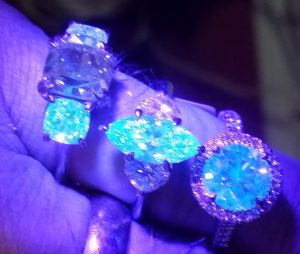How To Tell If A Diamond Is Real Or Fake?
Buying a diamond is a significant investment, especially in Melbourne, where the jewellery market offers everything...
Arguments around blue fluorescence diamond are probably never going to end. Most information you find anywhere is wrong. It comes from a lack of knowledge, common misconceptions and pure lies. Garry Holloway has been studying, buying and selling blue fluorescence diamonds for decades. Why? Because blue fluorescence diamonds he chooses look even BETTER than the non-fluorescent diamonds he sells.
In this article, we are going to discuss how Fluorescence and the Inclusions of the diamond can cause Diamond Engagement Rings to Look Blue and Dark in Sunlight.
After reading Some Good Diamonds Look Dark in Sunlight last week we have established that the Light Performance and Inclusions of a Diamond can have an effect on the way some diamonds appear under direct sunlight. The Cut of the diamond is an important characteristic to consider as the better the Cut, the darker a diamond will appear under direct sunlight.

Under long-wave Ultra-Violet Lighting.
The level of Fluorescence in the diamond can cause your diamond to appear dull. There is this common misconception that the blue colour that appears on the diamond under direct sunlight is always caused by natural diamond fluorescence. This is incorrect! As you can see in the comparison above, on the top image, the Marquise Cut diamond has stronger blue fluorescence than the Round Brilliant Cut diamond, yet it is not showing blue when put under direct sunlight (see the bottom image). The blue colour in the Round Brilliant Cut diamond is actually the reflection of the blue sky. So, the next time you notice a blue tint in a round cut diamond engagement ring, remember: it might just be the sky you’re seeing, not the diamond’s fluorescence.
IMAGE III: Men’s ring illustrating that the Diamond is Blue from Fluorescence in Sunlight
Milkiness that is often seen in blue fluorescent diamonds, like in the men’s ring shown in IMAGE III, is not created solely by fluorescence from strong UV light but by some types of inclusions when combined with fluorescence. These microscopic clouds light up when subjected to strong UV light. This phenomenon will be revealed to the rest of the world in some as yet unpublished research. Bear in mind that industry expert Garry Holloway rejects those diamonds.
A fluorescent diamond selected by Garry Holloway seen indoors shows no visual difference. A diamond rejected by Garry is seen under direct or shaded sunlight and the stone looks milky or chalky. The UV from sunlight activates the fluorescence inclusion effect. Garry has secret tests and rejects those diamonds.
A common reason why some diamonds may appear to be dull or dark in sunlight is due to the combination of fluorescence with the inclusions found in the diamond. The high level of fluorescence found in the Marquise Cut diamond is not causing it to have a milky or chalky effect because it has small crystal and needle inclusions that do not ‘light up’. The Round Brilliant Cut diamond appears dark in sunlight because it has a better cut as discussed in last week’s blog on Some Good Diamonds Look Dark in Sunlight . In closing, the blue hue is a result of the reflection of the blue sky.
READ MORE
Buying a diamond is a significant investment, especially in Melbourne, where the jewellery market offers everything...
Pink engagement rings have a distinct presence – delicate, expressive, and incredibly rare. At Holloway Diamonds, we...
Heading to the Mediterranean this season? While you soak up the sun, make sure your diamonds are just as radiant when...